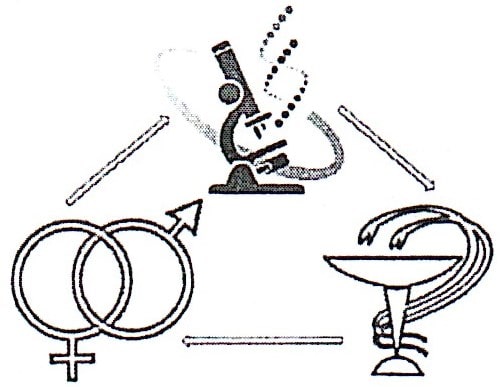Морфологічна характеристика печінки хвилястого папуги (Melopsittacus undulatus)
Анотація
Інформація стосовно особливостей нормальної морфології печінки хвилястого папуги є умовою для розробки ефективних методів профілактики і лікування хвороб органів травлення, розробки раціонів їх годівлі. Визначали особливості росту маси тіла, абсолютної і відносної маси і мікроскопічної будови печінки хвилястого папуги (Melopsittacus undulatus) 9 вікових груп: 1-, 3-, 7-, 14-, 21-добового, 1-, 2- і 6-місячного і 1-річного віку. Гістологічні парафінові зрізи виготовляли з правої частки згідно класичної методики, забарвлювали гематоксиліном і еозином, а також за Маллорі. Найбільш швидко маса тіла хвилястих папуг збільшувалась упродовж першого місяця постнатального періоду онтогенезу, упродовж якого – у перший тиждень. Маси дорослих птахів папуги досягали у 2-місячному віці. Найбільшого значення абсолютна маса печінка папуг сягала у 21-добовому віці, відносна маса – у 7-добовому. Через незначний вміст сполучної тканини, відсутність радіальності в розташуванні печінкових трубок, часточкова будова печінки папуг не була виражена і в цілому відповідала особливостям її морфології в птахів. Основними виразними структурами печінки папуг були печінкові трубки, що були розділені між собою кровоносними капілярами синусоїдного типу і іноді анастомозували між собою. На поздовжньому зрізі такі трубки складались з двох рядів гепатоцитів полігональної форми. На поперечному зрізі печінкові трубки містили в центральній частині жовчний капіляр і складались з 5-8 гепатоцитів, що мали вузький апікальний (жовчний) полюс і широкий базальний (васкулярний) полюс. У папуг молодшого віку іноді виявляли зрізи печінкових трубок, що мали форму кільця, стінка якого була утворена з двох рядів гепатоцитів, а його центральна частина містила кровоносний капіляр. Особливістю печінки пташенят 1-7-добового віку була наявність значної кількості дрібних осередків кровотворення, а також великої кількості жирових включень у гепатоцитах. Періоду найбільш інтенсивного росту маси тіла хвилястих папуг відповідали найбільші показники абсолютної і відносної маси печінки, відносної площі паренхіми, площі ядра і ядерно-цитоплазматичного відношення гепатоцитів.
Завантаження
Посилання
Abdelwahab, E. M. (1987). Ultrastructure and arrangement of hepatocyte cords in the duckling's liver. Journal of Anatomy, 150, 181-189.
Alshamy, Z., Richardson, K. C., Harash, G., Hünigen, H., Röhe, I., Hafez, H. M., Plendl, J. & Al Masri S. (2019). Structure and age-dependent growth of the chicken liver together with liver fat quantification: A comparison between a dual-purpose and a broiler chicken line. PLoS One. 14(12), e0226903. https://doi.org/10.1371/journal.pone.0226903
Amer, S. A., Behairy, A., Gouda, A., Abdel-Warith, A. A., Younis, E. M., Roushdy, E. M., Moustafa, A. A., Abd-Allah, N. A., Reda, R., Davies S. J. & Ibrahim, S. M. (2023). Dietary 1,3-β-glucans affect growth, breast muscle composition, antioxidant activity, inflammatory response, and economic efficiency in broiler chickens. Life (Basel), 13(3), 751. https://doi.org/10.3390/life13030751
Baker, J. R. (1980). A survey of causes of mortality in budgerigars (Melopsittacus undulatus). Veterinary Record. 106(1), 10-12. https://doi.org/10.1136/vr.106.1.10.
Beaufrère, H., Reavill, D., Heatley, J. & Susta, L. (2019). Lipid-related lesions in quaker parrots (Myiopsitta monachus). Veterinary Pathology, 56(2), 282-288. https://doi.org/10.1177/0300985818800025
Cassmann, E., Zaffarano, B., Chen, Q., Li, G. & Haynes, J. (2019). Novel siadenovirus infection in a cockatiel with chronic liver disease. Virus Research, 2(263), 164-168. https://doi.org/10.1016/j.virusres.2019.01.018
Cornejo, E. S., Dierenfeld, E. S., Bailey, C. A. & Brightsmith, D. J. (2012). Predicted metabolizable energy density and amino acid profile of the crop contents of free-living scarlet macaw chicks (Ara macao). Journal of Animal Physiology and Animal Nutrition (Berl), 96(6), 947-54. https://doi.org/10.1111/j.1439-0396.2011.01218.x
Donne, R., Saroul-Aïnama, M., Cordier, P., Celton-Morizur, S. & Desdouets, C. (2020). Polyploidy in liver development, homeostasis and disease. Nature Reviews Gastroenterology & Hepatology, 17(7), 391-405. https://doi.org/10.1038/s41575-020-0284-x
Earle, K. E. & Clarke, N. R. (1991). The nutrition of the budgerigar (Melopsittacus undulatus). The Journal of Nutrition, 121(11), 186-92. https://doi.org/10.1093/jn/121.suppl_11.s186
Eggleston, K. A., Schultz, E. M. & Reichard, D. G. (2019). Assessment of three diet types on constitutive immune parameters in captive budgerigar (Melopsittacus undulatus). Journal of Avian Medicine and Surgery, 33(4), 398-405. https://doi.org/10.1647/2018-395
Emery, N. J. (2006). Cognitive ornithology: the evolution of avian intelligence. Philosophical Transactions of the Royal Society B, 361(1465), 23–43. https://doi.org/10.1098/rstb.2005.1736
Feder, F. H. (1969). Beitrag zur makroskopischen und mikroskopischen anatomier des Verdauungsapparates beim Wellensittich (Melopsittacus undulatus). Annals of Anatomy – Anatomischer Anzeiger, 125(3), 233-255.
Gall, A. J., Burrough, E. R., Zhang, D. R, Magstadt, Yim-Im W., Stevenson, G. W., Derscheid, R. J., Piñeyro, P, Zheng, Y., Li, G. & Olds, J. E. (2020). Identification and correlation of a novel siadenovirus in a flock of budgerigars (Melopsittacus undulates) infected with salmonella typhimurium in the United States. Journal of Zoo and Wildlife Medicine, 51(3), 618-630. https://doi.org/10.1638/2019-0083
Higashiyama, H. & Kanai, Y. (2021). Comparative anatomy of the hepatobiliary systems in quail and pigeon, with a perspective for the gallbladder-loss. The Journal of Veterinary Medical Science, 83(5), 855-862. https://doi.org/10.1292/jvms.20-0669
Hünigen, H., Mainzer, K., Hirschberg, R. M., Custodis, P., Gemeinhardt, O., Al Masri, S., Richardson, K. C., Hafez, H. M. & Plendl, J. (2016). Structure and age-dependent development of the turkey liver: a comparative study of a highly selected meat-type and a wild-type turkey line. Poultry Science, 95(4), 901-11. https://doi.org/10.3382/ps/pev358
Jin Y., Anbarchian T. & Nusse R. (2022). Assessment of hepatocyte ploidy by flow cytometry. Methods in Molecular Biology, 2544, 171-181. https://doi.org/10.1007/978-1-0716-2557-6_12
Kushch, M. M., Byrka, O. V., Byrka, V. S. & Makhotina, D. S. (2018). Pokaznyky rostu masy tila i kyshechnyku kachok. Veterynariia, tekhnolohii tvarynnytstva ta pryrodokorystuvannia : naukovo-praktychnyi zhurnal, 1, 119-122. (in Ukraine).
Kushch, M. M., Konovalova, N. I., Byrka, V. S., Zhyhalova, O. Ye., Byrka, O. V., Fesenko, I. A. & Kushch, L. L. (2010). Patent Ukrainy na korysnu model 56832. Kyiv: Derzhavne patentne vidomstvo Ukrainy.
Larcombe, S. D., Tregaskes, C. A., Coffey, J., Stevenson, A. E., Alexander, L. G. & Arnold, K. E. (2015). Oxidative stress, activity behaviour and body mass in captive parrots. Conservation Physiology, 3(1), cov045. https://doi.org/10.1093/conphys/cov045
McRee, A. E., Higbie, C. T., Nevarez, J. G., Rademacher, N. T. & Tully, T. N. (2017). Mycobacteriosis in captive psittacines: a brief review and case series in common companion species (Eclectus roratus, Amazona oratrix, and Pionites melanocephala). Journal of Zoo and Wildlife Medicine, 48(3), 851-858. https://doi.org/10.1638/2016-0176.1
Nishimura, S., Sagara, A., Oshima, I., Ono, Y., Iwamoto, H., Okano, K., Miyachi H. & Tabata, S. (2009). Immunohistochemical and scanning electron microscopic comparison of the collagen network constructions between pig, goat and chicken livers. Animal science journal, 80(4), 451-459. https://doi.org/10.1111/j.1740-0929.2009.00660.x
Pedler R. L., Harris J. O., Thomson N. L., Buss J. J., Stone D. A. J. & Handlinger J. H. (2022). Development of a semi-quantitative scoring protocol for gill lesion assessment in greenlip abalone Haliotis laevigata held at elevated water temperature. Diseases of Aquatic Organisms, 150, 37-51. https://doi.org/10.3354/dao03673
Pekmezci, D., Yetismis, G., Esin, C., Duzlu, O., Colak, Z. N., Inci, A., Pekmezci, G. Z. & Yildirim, A. (2020). Occurrence and molecular identification of zoonotic microsporidia in pet budgerigars (Melopsittacus undulatus) in Turkey. Medical Mycology, 17. https://doi.org/10.1093/mmy/myaa088
Pizarro, M., Höfle, U., Rodríguez-Bertos A., González-Huecas M. & Castaño M. (2005). Ulcerative enteritis (quail disease) in lories. Avian Diseases, 49(4), 606-608. doi: https://doi.org/10.1637/7342-020805r.1
Polo, F. J., Peinado, V. I., Viscor, G. & Palomeque, J. (1998). Hematologic and plasma chemistry values in captive psittacine birds. Avian Diseases, 42(3), 523-35.
Schmidt, R. E., Reavill, D. R. & Phalen, D. N. (2003). Pathology of pet and aviary birds. Iowa State Press A Blackwell Publishing Company. 234 p.
Seeley, K. E., Baitchman, E., Bartlett, S., DebRoy, C. & Garner, M. M. (2014). Investigation and control of an attaching and effacing Escherichia coli outbreak in a colony of captive budgerigars (Melopsittacus undulatus). Journal of Zoo and Wildlife Medicine, 45(4), 875-82. https://doi.org/10.1638/2012-0281.1
Snyder, J. M. & Treuting, P. M. (2014). Pathology in practice. Adenocarcinoma of the proventriculus with liver metastasis and marked, diffuse chronic-active proventriculitis and ventriculitis with moderate M. ornithogaster infection in a budgerigar. Journal of the American Veterinary Medical Association, 244(6), 667-669. https://doi.org/10.2460/javma.244.6.667
Stornelli, M. R., Ricciardi, M. P., Giannessi, E. & Coli, A. (2006). Morphological and histological study of the ostrich (Struthio camelus L.) liver and biliary system. Italian Journal of Anatomy and Embryology, 111(1), 1-7.
Tunca, R., Toplu, N., Kırkan, S., Avci, H., Aydoğan, A., Epikmen, E.T. & Tekbiyik, S. (2012). Pathomorphological, immunohistochemical and bacteriological findings in budgerigars (Melopsittacus undulatus) naturally infected with S. gallinarum. Avian Pathology, 41(2), 203-209. https://doi.org/10.1080/03079457.2012.663076
Veladiano, I. A., Banzato, T., Bellini, L., Montani, A., Catania, S. & Zotti, A. (2016). Normal computed tomographic features and reference values for the coelomic cavity in pet parrots. BMC Veterinary Research, 12(1), 182. https://doi.org/10.1186/s12917-016-0821-6
Vizzotto L., Romani F., Ferrario V. F., Degna C. T. & Aseni P. (1989). Characterization by morphometric model of liver regeneration in the rat. American Journal of Anatomy, 185(4), 444-54. https://doi.org/10.1002/aja.1001850407
Westfahl, C., Wolf, P. & Kamphues, J. (2008). Estimation of protein requirement for maintenance in adult parrots (Amazona spp.) by determining inevitable N losses in excreta. Journal of Animal Physiology and Animal Nutrition (Berl). 92(3), 384-389. https://doi.org/10.1111/j.1439-0396.2008.00814.x
Wickermann, S. & Krautwald-Junghanns, M. E. (2021). Beurteilung der Haltungsbedingungen von Wellensittichen (Melopsittacus undulatus) und Nymphensittichen (Nymphicus hollandicus) in Deutschland [Evaluation of housing conditions of budgerigars (Melopsittacus undulatus) and cockatiels (Nymphicus hollandicus) in Germany]. Tierarztl Prax Ausg K Kleintiere Heimtiere. 49(6). 425-435. German. https://doi.org/10.1055/a-1668-9122
Yoshida, K., Yasuda, M., Nasu, T., Murakami, T. (2010). Scanning electron microscopic study of vascular and biliary casts in chicken and duck liver. Journal of Veterinary Medical Science, 72(7), 925-928. https://doi.org/10.1292/jvms.09-0516
Zaher, M., El-Ghareeb, A-W., Hamdi, H. & AbuAmod F. (2012). Anatomical, histological and histochemical adaptations of the avian alimentary canal to their food habits: I – Coturnix coturnix. Life Science Journal, 9(3), 253-275.
Zhakiyanova, M. S., Seilgazina, S. M., Ygiyeva, A., Dzhamanova, G. I. & Derbyshev, K. Y. (2023). Age changes in extramural digestive glands of sheep and rabbits in the postembryonic period. Open Veterinary Journal, (1), 123-130. https://doi.org/10.5455/ovj.2023.v13.i1.14
Переглядів анотації: 213 Завантажень PDF: 100





